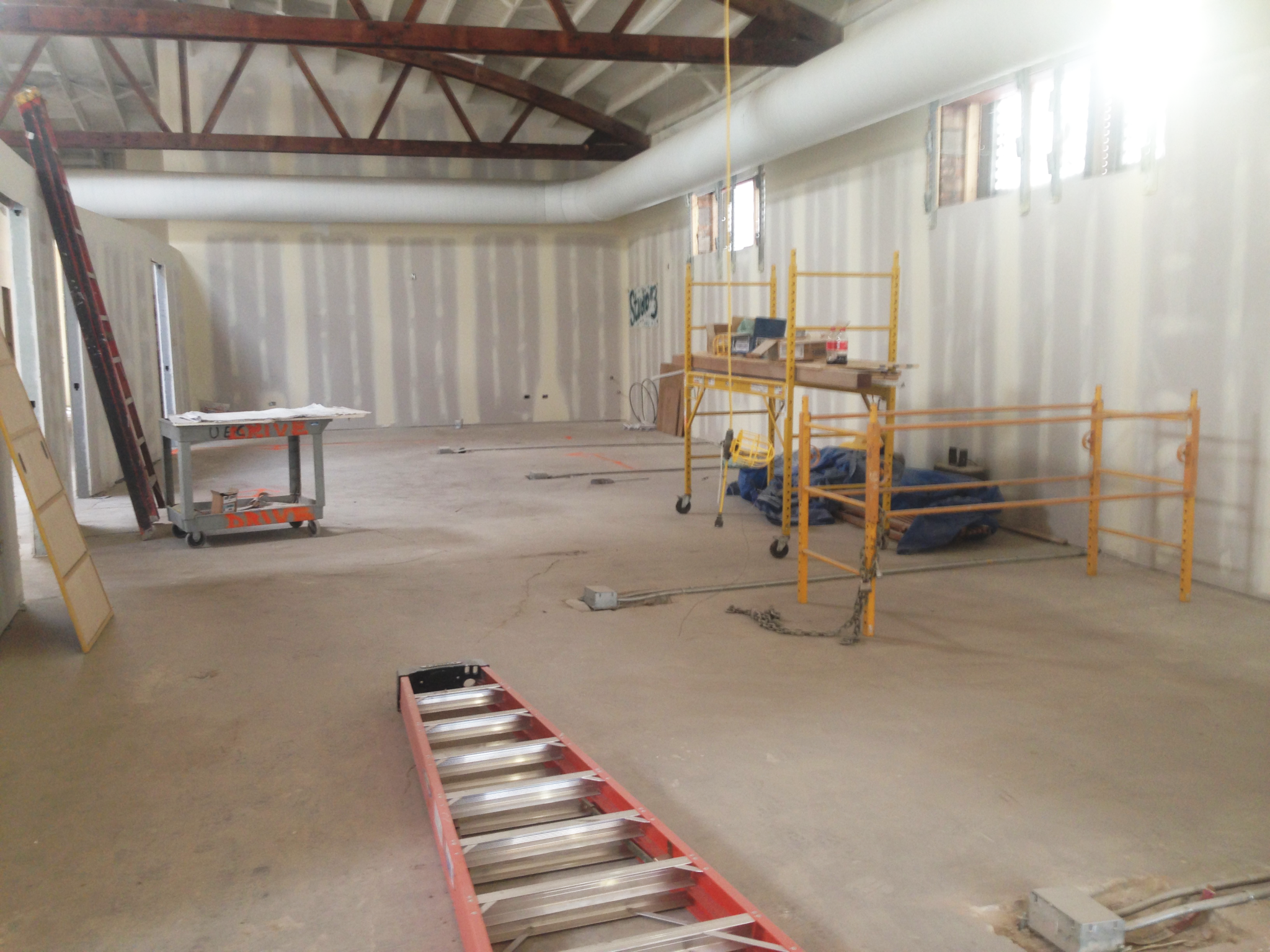The walls of the South Chicago Art Center are lined with artwork and boxes full of materials that are labeled in both English and Spanish. A poster on the wall lists several class rules: “No saying ‘shut up’ ”; “No calling people ‘Boy’ or ‘Girl”; “Respect yourself, your peers, your teachers, and the Art Center!”
On Wednesday morning, Development Manager Billy McGuinness and Operations Manager Laura Trejo are hard at work preparing the room for that afternoon’s class, in which students from across the street at Our Lady of Guadalupe School will learn how to make rhombicuboctahedron sculptures—structures with eight triangular faces and eighteen square faces. They’re also preparing for a hard hat tour of the facility they are moving into three blocks away, at the intersection of 91st and Houston. McGuinness hands me a folder with various documents that explain Executive Director Sarah Ward’s vision for their new facility, which previously housed a dry cleaning service. Ward expects the new facility to allow her organization to “triple its programs and double the number of young people served” by September 2015. When it moves, the South Chicago Art Center will adopt a new name: SkyART.
In 2001, Ward left her job providing art therapy to kids on probation at Cook County Juvenile Court to found the South Chicago Art Center. The first eighteen students began class on September 11 of that year. The program has now grown to provide over 3,000 students ages six to eighteen with free arts programming, with 200 students attending classes at the center. Through its School SmARTs and Street SmARTs programs, the center provides in-school, after-school and out-of-school programs at its current facility, libraries, and other locations. In addition, the South Chicago Art Center helps students with college admission through its College SmARTs program and offers arts education to parents through its Adult SmARTs program.
With a new building and a new name, Ward plans to continue the organization’s agenda: empowering students through art. According to McGuinness, students can “access a different way of learning” through art. Ward does not see her organization’s empowerment of kids as limited purely to arts—they are also taught to care for plants in their nearby Community Artists Garden, and learn math skills through art projects related to geometry. “I think if you think myopically about…arts education, you are missing the whole picture of the needs that really exist in the neighborhood,” Ward said.
While the current eight-hundred square foot South Chicago Art Center building has just one (darkened) window, SkyART’s new home will be six thousand square feet and lined with windows along its exterior. The new building will house multiple offices, a conference room, three studios, a kitchen, a kiln room, and a computer room. When SkyART moves, the art center’s current landlord, the Church of Our Lady Guadalupe, will convert the old facility into a food pantry.
Alva Nelms, who has taught at the art center for about a year and taught the rhombicuboctahedron sculpture class, welcomes the move to the new facility in part because the new cement floor will enable her to teach students how to weld. “This space is full of creativity,” Nelms also said. “If we have five times more space, we’ll have five times more creativity.”
SkyART has raised over $1 million of its goal of $2.5 million—roughly $1 million for the facility and another $1.5 million for capacity building and program growth. They have received money mainly from foundations, but Ward hopes to gain more support from corporate and individual donors. During the tour, Ward showed some of these potential donors the new facility and explained how it is intended to enhance students’ learning.
Ward believes that moving to the facility three blocks away, across the Metra tracks, will allow students safer and more convenient access to the center. According to Ward, there are twelve active gangs operating in South Chicago, posing a problem for students who live across the train tracks and wish to come to the art center. “It becomes a space where there’s no way a kid would walk over here,” Ward said. “Why would they walk over here if they don’t go to church or school [here]?” The location of the new facility is more gang neutral, she said, in part because of its proximity to a larger shopping district.
Ward saw the move as an opportunity to change the organization’s name and clearly differentiate it from organizations such as the South Side Community Art Center, Hyde Park Art Center, and the Beverly Arts Center. “No one could get the name right,” Ward said. She intended South Chicago Art Center to be only a temporary name.
“I had no idea when you pick a name, it sticks,” she said. “I mean, I’d never run an organization before. I thought I could easily change it.”
In recent months, Ward consulted with board members and allowed the students to vote on potential names. The chosen name was Skyway Art, after the nearby Skyway toll road, but a shortened version of that name was settled on after a board member pointed out that people take the Skyway in order to avoid the neighborhood. For Ward, SkyART captured the very essence of her organization. “SkyART was really catchy,” she said. “Our whole tagline is realizing the limitless potential of youth, and that’s what we really believe in.”
Correction: An earlier version of this story incorrectly stylized SkyART as skyart. It also used the word “limited” instead of “limitless” in the final quote, an error of transcription. The center serves over 3,000 students, not 2,000 as previously stated.



